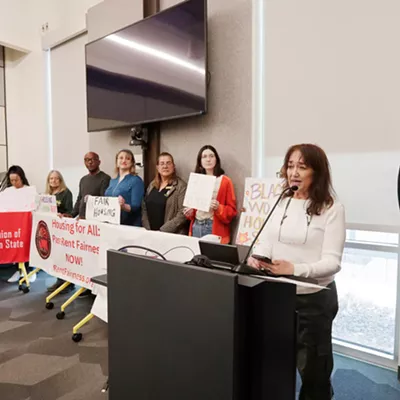They say the EPA calculations are absurd and (using the level of phosphorus allowed in the river in Washington and Idaho) say the math is 2+2=2.
"It's a handy catchphrase, but unfortunately it is not correct," says Tom Eaton, the EPA administrator who made the ruling that the amount of phosphorus in the Spokane River at the state line can be considered the "natural condition" of the water. Eaton, associate regional administrator for EPA's Region 10 (the Pacific Northwest), says there is a bigger issue of states' rights he had to address.
The Washington Department of Ecology has worked for the last decade on a plan to set the allowable limits, the total maximum daily load (TMDL) of phosphorus in the Spokane River to increase levels of dissolved oxygen in the water -- basically, the more oxygen, the healthier the water. The Spokane River -- its flows choked off by dams through summer and early fall -- has been considered an impaired waterway for decades.
& lt;span class= "dropcap " & P & lt;/span & hosphorus enters the river primarily from municipal wastewater treatment plants -- Spokane's being the largest contributor -- as well as from Kaiser/Trentwood and Inland Empire Paper's pulp mill. Tributaries -- notably Latah Creek -- add to the load with fertilizer runoff.
The phosphorus contributes to persistent, and sometimes toxic, algae blooms in Long Lake, where the river nearly comes to a stop behind Long Lake Dam. When the algae blooms die, the plants sink, decompose and suck oxygen out of the deeper water layers, especially when river flows are low.
Washington's Department of Ecology, Eaton says, quite naturally creates a plan "to pull in all dischargers and all sources of the pollutant and allocate shares of that pollutant where they can still meet the water standard.
"The state of Washington does not have the authority to reach into the state of Idaho and tell the state of Idaho what it can and cannot do. That's a states' rights issue," Eaton says.
"Tom is nuancing this when it comes to states' rights," says Rick Eichstaedt, an attorney well-versed in water law at the Center for Justice in Spokane. "I agree [Washington] Ecology can't write TMDLs to require Idaho to do anything, but EPA is required by the federal Clean Water Act ... to make sure they are not causing or contributing to violations of downstream water standards."
Eaton disagrees. The impaired waters are in Washington, not Idaho, he says.
"This is where 2+2 breaks down. Rick's argument is based on the assumption that the state of Washington can go into Idaho and set waste load allocations ... and they cannot," he says.
But Eichstaedt points out Washington Ecology's original draft of a TMDL on phosphorus did measure the "natural condition" of the river at its outlet from Lake Coeur d'Alene, upstream of wastewater discharges from the cities of Hayden, Coeur d'Alene and Post Falls.
That plan, released in 2004, was stalled by two years of negotiation after dischargers threatened to sue, saying the standards were expensive and tough to meet. During the negotiations, EPA signed permits for Idaho dischargers along the Spokane River and reset the "natural condition" of the water to the state line. That change was assailed by scientists at both state and federal agencies.
Hydrologist Drea Trauemer, who was compiling the new draft cleanup plan for Washington Ecology, abruptly quit last month saying EPA's decision (and other factors) made the plan indefensible legally and scientifically. Two other scientists also have quit or were removed from working on the new plan.
"So the thing about it being a federal Clean Water Act is that it's a natural resource and there is a duty to deal with it on both sides of the state line," Eichstaedt says. "How can this be legal? If you nuance it the way Tom does then he's right, but it ignores their independent duty."
Eichstaedt adds that the three dischargers in Idaho are allowed the same amount of phosphorus as the four, much larger, dischargers in Washington, which also bears all the runoff and other so-called nonpoint sources of pollution.
"Basically the dischargers in Idaho are off the hook," Eichstaedt says.
& lt;span class= "dropcap " & S & lt;/span & uch conflicts aren't unique to the Washington-Idaho line; in fact, Massachusetts and Rhode Island are engaged in litigation over similar issues. But Eaton says the whole thing is overblown. "At current levels, cumulative loading of phosphorus is 5 percent of phosphorus in the river," he says, saying cleanup in Washington will do far more for better water.
"Cities on both sides of the border will be installing the same technology at the same pace to try and achieve the same target and we will see dramatic improvement in Long Lake," Eaton predicts.
If review of dissolved oxygen levels show that standards are not being met, Eaton says, "then we are committed to reassess if Idaho dischargers are in fact causing water quality problems in Washington and, if so, readjust the permits."
Meanwhile ...
A federal court ruling Monday may open another issue for the Spokane River Cleanup plan. The Ninth Circuit Court of Appeals Monday ruled unanimously that the EPA cannot allow a discharger (in this case an Arizona copper mine) to put more pollutant into an already impaired river before the pollution already in the river is reduced. The ruling appears to have direct application to Spokane County's ability to get a permit for its planned wastewater treatment plant on the Spokane River.
















